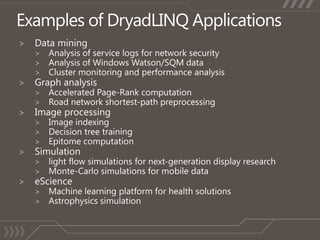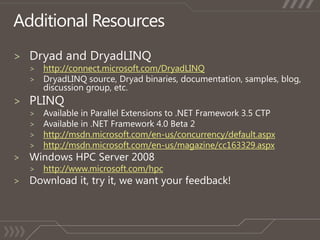SVR17: Data-Intensive Computing on Windows HPC Server with the ...
- 1. Data-Intensive Computing on Windows HPC Server with the DryadLINQ FrameworkJohn VertArchitectMicrosoft CorporationSVR17
- 2. Moving PartsWindows HPC Server 2008 – cluster management, job schedulingDryad – distributed execution engine, failure recovery, distribution, scalability across very large partitioned datasetsLINQ – .NET extensions for declarative query, easy expression of data parallelism, unified data modelPLINQ – multi-core parallelism across LINQ queries.DryadLINQ – Bring LINQ ease of programming to Dryad
- 3. Software Stack…ImageProcessingMachineLearningGraphAnalysisDataMining.NET ApplicationsDryadLINQDryadHPC Job SchedulerWindows HPC Server 2008Windows HPC Server 2008Windows HPC Server 2008Windows HPC Server 2008
- 4. DryadProvides a general, flexible distributed execution layerDataflow graph as the computation modelCan be modified by runtime optimizationsHigher language layer supplies graph, vertex code, serialization code, hints for data localityAutomatically handles distributed executionDistributes code, routes dataSchedules processes on machines near dataMasks failures in cluster and network
- 5. A Dryad JobDirected acyclic graph (DAG)OutputsProcessingverticesChannels(file, fifo, pipe)Inputs
- 6. 2-D PipingUnix Pipes: 1-Dgrep | sed | sort | awk | perlDryad: 2-D grep1000 | sed500 | sort1000 | awk500 | perl506
- 7. LINQLanguage Integrated QueryDeclarative extensions to C# and VB.NET for iterating over collectionsIn memoryVia data providersSQL-LikeBroadly adoptable by developersEasy to useReduces written codePredictable resultsScalable experienceDeep tooling support
- 8. PLINQ Parallel Language Integrated QueryValue Proposition:Enable LINQ developers to take advantage of parallel hardware—with basic understanding of data parallelism.Declarative data parallelism (focus on the “what” not the “how”)Alternative to LINQ-to-ObjectsSame set of query operators + some extrasDefault is IEnumerable<T> basedPreview in Parallel Extensions to .NET Framework 3.5 CTPShipping in .NET Framework 4.0 Beta 2
- 9. DryadLINQLINQ to clustersDeclarative programming style of LINQ for clustersAutomatic parallelizationParallel query plan exploits multi-node parallelismPLINQ underneath exploits multi-core parallelismIntegration with VS and .NETType safety, automatic serializationQuery plan optimizationsStatic optimization rules to optimize localityDynamic run-time optimizations
- 10. DryadLINQ: From LINQ to DryadAutomatic query plan generationDistributed query execution by DryadLINQ queryQuery planDryadvarlogentries =from line in logswhere !line.StartsWith("#")select new LogEntry(line);logswhereselect
- 11. A Simple LINQ QueryIEnumerable<BabyInfo> babies = ...; varresults = from baby in babieswhere baby.Name == queryName &&baby.State == queryState &&baby.Year >= yearStart && baby.Year <= yearEndorderbybaby.Yearascendingselect baby;
- 12. A Simple PLINQ QueryIEnumerable<BabyInfo> babies = ...; varresults = from baby in babies.AsParallel()where baby.Name == queryName &&baby.State == queryState &&baby.Year >= yearStart && baby.Year <= yearEndorderbybaby.Yearascendingselect baby;
- 13. A Simple DryadLINQQueryPartitionedTable<BabyInfo> babies = PartitionedTable.Get<BabyInfo>(“BabyInfo.pt”);varresults = from baby in babies where baby.Name == queryName &&baby.State == queryState &&baby.Year >= yearStart && baby.Year <= yearEndorderbybaby.Yearascendingselect baby;
- 14. PartitionedTable<T>Core data structure for DryadLINQScale-out, partitioned container for .NET objectsDerives from IQueryable<T>, IEnumerable<T>ToPartitionedTable() extension methodsDryadLINQ operators consume and produce PartitionedTable<T>DryadLINQ generates code to serialize/deserialize your .NET objectsUnderlying storage can be partitioned file, partitioned SQL table, cluster filesystem
- 15. Partitioned FileFile-based container for PartitionedTable<T> metadataXC\output\520a0fcf\Part200,1855000,HPCMETAHN011,1630000,HPCA1CN132,1707500,HPCA1CN123,1828820,HPCA1CN224,1802140,HPCA1CN075,1741000,HPCA1CN086,1733980,HPCA1CN117,1762620,HPCA1CN068,1861300,HPCA1CN149,1807460,HPCA1CN1710,1807560,HPCA1CN2311,1768120,HPCA1CN2012,1847220,HPCA1CN0313,1729160,HPCA1CN1614,1767500,HPCA1CN0515,1781520,HPCA1CN0416,1728480,HPCA1CN0917,1802580,HPCA1CN1818,1862380,HPCA1CN1019,1762540,HPCA1CN21\\HPCMETAHN01\XC\output\520a0fcf\Part.00000000
- 16. PartitionedFileFile-based container for PartitionedTable<T> metadataXC\output\520a0fcf\Part200,1855000,HPCMETAHN011,1630000,HPCA1CN132,1707500,HPCA1CN123,1828820,HPCA1CN224,1802140,HPCA1CN075,1741000,HPCA1CN086,1733980,HPCA1CN117,1762620,HPCA1CN068,1861300,HPCA1CN149,1807460,HPCA1CN1710,1807560,HPCA1CN2311,1768120,HPCA1CN2012,1847220,HPCA1CN0313,1729160,HPCA1CN1614,1767500,HPCA1CN0515,1781520,HPCA1CN0416,1728480,HPCA1CN0917,1802580,HPCA1CN1818,1862380,HPCA1CN1019,1762540,HPCA1CN21\\HPCMETAHN01\XC\output\520a0fcf\Part.00000000\\HPCA1CN13\XC\output\520a0fcf\Part.00000001\\HPCA1CN12\XC\output\520a0fcf\Part.00000002\\HPCA1CN22\XC\output\520a0fcf\Part.00000003\\HPCA1CN07\XC\output\520a0fcf\Part.00000004\\HPCA1CN08\XC\output\520a0fcf\Part.00000005\\HPCA1CN11\XC\output\520a0fcf\Part.00000006\\HPCA1CN06\XC\output\520a0fcf\Part.00000007\\HPCA1CN14\XC\output\520a0fcf\Part.00000008\\HPCA1CN17\XC\output\520a0fcf\Part.00000009\\HPCA1CN23\XC\output\520a0fcf\Part.00000010\\HPCA1CN20\XC\output\520a0fcf\Part.00000011\\HPCA1CN03\XC\output\520a0fcf\Part.00000012\\HPCA1CN16\XC\output\520a0fcf\Part.00000013\\HPCA1CN05\XC\output\520a0fcf\Part.00000014\\HPCA1CN04\XC\output\520a0fcf\Part.00000015\\HPCA1CN09\XC\output\520a0fcf\Part.00000016\\HPCA1CN18\XC\output\520a0fcf\Part.00000017\\HPCA1CN10\XC\output\520a0fcf\Part.00000018\\HPCA1CN21\XC\output\520a0fcf\Part.00000019
- 17. A typical data-intensive queryvar logs = PartitionedTable.Get<string>(“weblogs.pt”);varlogentries = from line in logs where !line.StartsWith("#") select new LogEntry(line);var user = from access in logentries where access.user.EndsWith(@"\jvert") select access;var accesses = from access in user group access by access.page into pages select new UserPageCount(“jvert", pages.Key, pages.Count());varhtmAccesses = from access in accesses where access.page.EndsWith(".htm")orderbyaccess.count descending select access; Go through logs and keep only lines that are not comments. Parse each line into a new LogEntryobject.Go through logentries and keep only entries that are accesses by jvert.Group jvertaccesses according to what page they correspond to. For each page, count the occurrences.Sort the pages jverthas accessed according to access frequency.
- 18. Dryad Parallel DAG executionlogslogentriesvarlogentries =from line in logs where !line.StartsWith("#") select new LogEntry(line);var user = from access in logentries where access.user.EndsWith(@"\jvert") select access;var accesses = from access in user group access by access.page into pages select new UserPageCount(“jvert", pages.Key, pages.Count());varhtmAccesses = from access in accesses where access.page.EndsWith(".htm")orderbyaccess.count descending select access; useraccesseshtmAccessesoutput
- 19. Query plan generationSeparation of query from its execution contextAdd all the loaded assemblies as resourcesEliminate references to local variables by partially evaluating all the expressions in the queryDistribute objects used by the queryDetect impure queries when possibleAutomatic code generationObject serialization code for Dryad channelsManaged code for Dryad VerticesStatic query plan optimizationsPipelining: composing multiple operators into one vertexMinimize unnecessary data repartitionsOther standard DB optimizations
- 20. DryadLINQ query planQuery 0 Output: file://\\hpcmetahn01\XC\output\b7e651a4-38b7-490c-8399-f63eaba7f29a.ptDryadLinq0.dll was built successfully.Input: [PartitionedTable: file://weblogs.pt]Super__1: Where(line => !(line.StartsWith(_))) Select(line => new logdemo.LogEntry(line)) Where(access => access.user.EndsWith(_))DryadGroupBy(access => access.page,(k__0, pages) => new LinqToDryad.Pair<String,Int32>(k__0, pages.Count()))DryadHashPartition(e => e.Key,e => e.Key)Super__12:DryadMerge()DryadGroupBy(e => e.Key,e => e.Value,(k__0, g__1) => new LinqToDryad.Pair<String,Int32>(k__0, g__1.Sum())) Select(pages => new logdemo.UserPageCount(_, pages.Key, pages.Count()))
- 21. XML representationGenerated by DryadLINQ and passed to Dryad<Query> <DryadLinqVersion>1.0.1401.0</DryadLinqVersion> <ClusterName>hpcmetahn01</ClusterName> ... <Resources> <Resource>wrappernativeinfo.dll</Resource> <Resource>DryadLinq0.dll</Resource> <Resource>System.Threading.dll</Resource> <Resource>logdemo.exe</Resource> <Resource>LinqToDryad.dll</Resource> </Resources> <QueryPlan> <Vertex> <UniqueId>0</UniqueId> <Type>InputTable</Type> <Name>weblogs.pt</Name> ... </Vertex><Vertex><UniqueId>1</UniqueId> <Type>Super</Type> <Name>Super__1</Name> ...<Children><Child> <UniqueId>0</UniqueId> </Child></Children></Vertex> ... </QueryPlan><Query>List of files to be shipped to the clusterVertex definitions
- 22. DryadLINQ generated codeCompiled at runtime, assembly passed to Dryad to implement vertices public sealed class DryadLinq__Vertex { public static int Super__1(string args){ < . . . >DryadVertexEnvdenv = new DryadVertexEnv(args, dvertexparam);var dwriter__2 = denv.MakeWriter(DryadLinq__Extension.FactoryType__0);var dreader__3 = denv.MakeReader(DryadLinq__Extension.FactoryString);var source__4 = DryadLinqVertex.DryadWhere(dreader__3, line => (!(line.StartsWith(@"#"))), true);var source__5 = DryadLinqVertex.DryadSelect(source__4, line => new logdemo.LogEntry(line), true);var source__6 = DryadLinqVertex.DryadWhere(source__5, access => access.user.EndsWith(@"\jvert"), true);var source__7 = DryadLinqVertex.DryadGroupBy(source__6, access => access.page, (k__0, pages) => new LinqToDryad.Pair<System.String,System.Int32>(k__0, pages.Count<logdemo.LogEntry>()), null, true, true, false);DryadLinqVertex.DryadHashPartition(source__7, e => e.Key, null, dwriter__2);DryadLinqLog.Add("Vertex Super__1 completed at {0}", DateTime.Now.ToString("MM/dd/yyyyHH:mm:ss.fff")); return 0; } public static int Super__12(string args){< . . . > }
- 23. DryadLINQ query operatorsAlmost all the useful LINQ operatorsWhere, Select, SelectMany, OrderBy, GroupBy, Join, GroupJoin, Distinct, Concat, Union, Intersect, Except, Count, Contains, Sum, Min, Max, Average, Any, All, Skip, Take, AggregateOperators introduced by DryadLINQHashPartition, RangePartition, Merge, ForkDryad ApplyOperates on sequences rather than items
- 24. MapReduce in DryadLINQMapReduce(source, // sequence of Ts mapper, // T -> MskeySelector, // M -> K reducer) // (K, Ms) -> Rs{var map = source.SelectMany(mapper);var group = map.GroupBy(keySelector);var result = group.SelectMany(reducer); return result; // sequence of Rs}
- 25. K-means in DryadLINQpublic static Vector NearestCenter(Vector v, IEnumerable<Vector> centers) { return centers.Aggregate((r, c) => (r - v).Norm2() < (c - v).Norm2() ? r : c);}public static IQueryable<Vector> Step(IQueryable<Vector> vectors, IQueryable<Vector> centers) { return vectors.GroupBy(point => NearestCenter(point, centers)).Select(group => group.Aggregate((x,y) => x + y) / group.Count());}var vectors = PartitionedTable.Get<Vector>("vectors.pt");IQueryable<Vector> centers = vectors.Take(100);for (int i = 0; i < 10; i++) { centers = Step(vectors, centers);}centers.ToPartitionedTable<Vector>(“centers.pt”);public class Vector { public double[] entries; [Associative] public static Vector operator +(Vector v1, Vector v2) { … } public static Vector operator -(Vector v1, Vector v2) { … } public double Norm2() {…}}
- 26. Putting it all togetherIt’s LINQ all the way downMajor League Baseball datasetPitch-by-pitch data for every MLB game since 200747,909 pitch XML files (one for each pitcher appearance)6,127 player XML files (one for each player)Hash partition the input data files to distribute the workLINQ to XML to shred the dataDryadLINQ to analyze dataset
- 27. Load the dataset and partitionDefine Pitch and Player classesvoid StagePitchData(string[] fileList, string PartitionedFile){// partition the list of filenames across // 20 nodes of the clustervarpitches = fileList.ToPartitionedTable("filelist") .HashPartition((x) => (x), 20).SelectMany((f) => XElement.Load(f).Elements("atbat")).SelectMany((a) => a.Elements("pitch").Select((p) => new Pitch((string)a.Attribute("pitcher"), (string)a.Attribute("batter"),p)));pitches.ToPartitionedTable(PartitionedFile);}Void StagePlayerData(string[] fileList, string PartitionedFile){varplayers = fileList.Select((p) => new Player(XElement.Load(p)));players.ToPartitionedTable(PartitionedFile); return 0;}
- 28. Analyze dataset with LINQIQueryable<Pitch> FindFastest(IQueryable<Pitch> pitches, intcount){ return pitches.OrderByDescending((p) => p.StartSpeed) .Take(count);}
- 29. Supports LINQ JoinsIQueryable<string> FindFastestPitchers(IQueryable<Pitch> pitches,IQueryable<Player> players,intcount){ return pitches.OrderByDescending((p) => p.StartSpeed) .Take(count) .Join(players, (o) => o.Pitcher, (i) => i.Id, (o, i) => i.FirstName + " " + i.LastName) .Distinct();}
- 30. DryadLINQ on HPC ServerDryadLINQ program runs on client workstationDevelop, debug, run locallyWhen ToPartitionedTable() is called, the query expression is materialized (codegen, query plan, optimization) and a job is submitted to HPC ServerHPC Server allocates resources for the job and schedules the single task. This task is the Dryad Job ManagerThe JM then schedules additional tasks to execute the vertices of the DryadLINQ queryWhen the job completes, the client program picks up the output result and continues.
- 31. Examples of DryadLINQ ApplicationsData miningAnalysis of service logs for network securityAnalysis of Windows Watson/SQM dataCluster monitoring and performance analysisGraph analysisAccelerated Page-Rank computationRoad network shortest-path preprocessingImage processingImage indexingDecision tree trainingEpitome computationSimulationlight flow simulations for next-generation display researchMonte-Carlo simulations for mobile dataeScienceMachine learning platform for health solutionsAstrophysics simulation
- 32. Ongoing WorkAdvanced query optimizationsCombination of static analysis and annotationsSampling execution of the query planDynamic query optimizationIncremental computationReal-time event processingGlobal schedulingDynamically allocate cluster resources between multiple concurrent DryadLINQ applicationsScale-out partitioned storagePluggable storage providersDryadLINQ on AzureBetter debugging, performance analysis, visualization, etc.
- 33. Additional ResourcesDryad and DryadLINQhttp://connect.microsoft.com/DryadLINQDryadLINQ source, Dryad binaries, documentation, samples, blog, discussion group, etc.PLINQAvailable in Parallel Extensions to .NET Framework 3.5 CTPAvailable in .NET Framework 4.0 Beta 2http://msdn.microsoft.com/en-us/concurrency/default.aspxhttp://msdn.microsoft.com/en-us/magazine/cc163329.aspxWindows HPC Server 2008http://www.microsoft.com/hpcDownload it, try it, we want your feedback!
- 34. Questions?
- 35. YOUR FEEDBACK IS IMPORTANT TO US!Please fill out session evaluation forms online atMicrosoftPDC.com
- 36. Learn More On Channel 9Expand your PDC experience through Channel 9.Explore videos, hands-on labs, sample code and demos through the new Channel 9 training courses.channel9.msdn.com/learnBuilt by Developers for Developers….



















![DryadLINQ query planQuery 0 Output: file://\\hpcmetahn01\XC\output\b7e651a4-38b7-490c-8399-f63eaba7f29a.ptDryadLinq0.dll was built successfully.Input: [PartitionedTable: file://weblogs.pt]Super__1: Where(line => !(line.StartsWith(_))) Select(line => new logdemo.LogEntry(line)) Where(access => access.user.EndsWith(_))DryadGroupBy(access => access.page,(k__0, pages) => new LinqToDryad.Pair<String,Int32>(k__0, pages.Count()))DryadHashPartition(e => e.Key,e => e.Key)Super__12:DryadMerge()DryadGroupBy(e => e.Key,e => e.Value,(k__0, g__1) => new LinqToDryad.Pair<String,Int32>(k__0, g__1.Sum())) Select(pages => new logdemo.UserPageCount(_, pages.Key, pages.Count()))](https://image.slidesharecdn.com/svr17-dataintensive-computing-on-windows-hpc-server-with-the723/85/SVR17-Data-Intensive-Computing-on-Windows-HPC-Server-with-the-20-320.jpg)




![K-means in DryadLINQpublic static Vector NearestCenter(Vector v, IEnumerable<Vector> centers) { return centers.Aggregate((r, c) => (r - v).Norm2() < (c - v).Norm2() ? r : c);}public static IQueryable<Vector> Step(IQueryable<Vector> vectors, IQueryable<Vector> centers) { return vectors.GroupBy(point => NearestCenter(point, centers)).Select(group => group.Aggregate((x,y) => x + y) / group.Count());}var vectors = PartitionedTable.Get<Vector>("vectors.pt");IQueryable<Vector> centers = vectors.Take(100);for (int i = 0; i < 10; i++) { centers = Step(vectors, centers);}centers.ToPartitionedTable<Vector>(“centers.pt”);public class Vector { public double[] entries; [Associative] public static Vector operator +(Vector v1, Vector v2) { … } public static Vector operator -(Vector v1, Vector v2) { … } public double Norm2() {…}}](https://image.slidesharecdn.com/svr17-dataintensive-computing-on-windows-hpc-server-with-the723/85/SVR17-Data-Intensive-Computing-on-Windows-HPC-Server-with-the-25-320.jpg)

![Load the dataset and partitionDefine Pitch and Player classesvoid StagePitchData(string[] fileList, string PartitionedFile){// partition the list of filenames across // 20 nodes of the clustervarpitches = fileList.ToPartitionedTable("filelist") .HashPartition((x) => (x), 20).SelectMany((f) => XElement.Load(f).Elements("atbat")).SelectMany((a) => a.Elements("pitch").Select((p) => new Pitch((string)a.Attribute("pitcher"), (string)a.Attribute("batter"),p)));pitches.ToPartitionedTable(PartitionedFile);}Void StagePlayerData(string[] fileList, string PartitionedFile){varplayers = fileList.Select((p) => new Player(XElement.Load(p)));players.ToPartitionedTable(PartitionedFile); return 0;}](https://image.slidesharecdn.com/svr17-dataintensive-computing-on-windows-hpc-server-with-the723/85/SVR17-Data-Intensive-Computing-on-Windows-HPC-Server-with-the-27-320.jpg)










